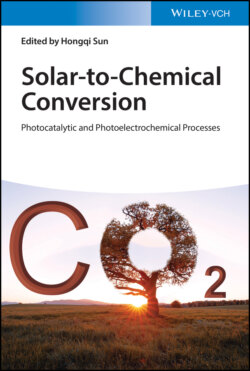Читать книгу Solar-to-Chemical Conversion - Группа авторов - Страница 18
2.4.1.1 Methane (CH4)
ОглавлениеAs a high value‐added fuel, CH4, a natural gas, is widely used in residential living and industrial activities. Reduction of CO2 to methane named by the methanation process is of substantial importance in industrial field as the following equation: CO2 + 2H2 → CH4 + 2H2O. In general, this reaction is proceeded at high temperatures and pressures in the presence of metal catalysts, for example, Ru, Mo, and Ni. However, inspired by natural photosynthesis, chemists expect to produce CH4 fuel under mild and environment‐friendly conditions. In 1986, Willner and coworker reported an exciting result, in which gaseous CH4 was successfully synthesized with a 0.0025% of quantum yield by using a Ru(bpz)32+ as sensitizer and Ru metal colloid as catalyst under visible‐light irradiation [25]. In Figure 2.8, the reaction mechanism displayed that Ru*(bpz)32+ produced from the light‐excited Ru(bpz)32+ can be reduced by triethanolamine (TEOA) as electron donor into Ru(bpz)3+ that can pair with Ru(bpz)32+ with a redox potential of −0.86 V vs. Saturated Calomel Electrode (SCE). On the other hand, it is demonstrated that the redox potential of CH4/CO2 is equal to −0.24 V vs. NHE, which is less negative than that of Ru(bpz)3+/Ru(bpz)32+. As a result, CO2 molecular can be thermodynamically reduced into CH4 molecular by Ru(bpz)3+ over Re metal catalyst in acidic media according to the Eq. (2.7).
Figure 2.8 Schematic cycle for the photosensitized reduction of CO2 to CH4.
Source: Maidan and Willner [25].
However, the chemical yield of CH4 from this expensive organic/inorganic photocatalytic system is low and unsustainable. In 1995, Kamber and coworkers took advantage of popular photocatalyst TiO2 to reduce gaseous CO2 into CH4 under ultraviolet (UV) illumination at moderate temperature while the chemical yield and selectivity is not satisfying due to the nonspecific reaction over semiconductor photocatalysts [26]. The chemical yield of CO and H2 is 27 and 14 times higher than that of CH4, which indicated CH4 seemed the by‐products and the formation reactions of CO and H2 are the dominant reduction reaction.
Considering the commercial implication in future, the selectivity to CH4 is a key challenge in transforming CO2 into CH4. Recently, Tasbihi et al. reported Pt/TiO2/mesoporous SiO2 photocatalyst for significant enhancement of selectivity to CH4 [27]. The main motivation of constructing this system is to elucidate that the introduced platinum (Pt) not only increases the activity of TiO2 catalysts for CO2 reduction but also modifies the selectivity toward highly reduced products. It is reported that compared with other noble cocatalysts, such as palladium, gold, silver, and rhodium, platinum has shown exceptional selectivity to methane in CO2 photoreduction, and, therefore, the Pt nanoparticles are to be expected to improve the selectivity of catalytic processes [28]. To further reduce the cost of photocatalysts for CH4 production, transition metal elements are investigated to substitute noble metal as well as maintain high selectivity. For example, Zhao and coworkers prepared a surface La‐modified TiO2 photocatalyst through a facile sol–gel route [29]. It was found that the La species was deposited on the surface of TiO2 in the form of La2O3. More importantly, small part of La atoms replaced surface Ti atom forming a Ti—O—La bond, resulting in the generation of oxygen vacancies (OVs) and Ti3+, which synergistically contributed to the enhanced CO2 adsorption, water vapor activation, and charge separation. Finally, the selectivity to CH4 in La‐modified TiO2 reached to ∼80% compared with ∼20% selectivity of TiO2. Meanwhile, Ye and coworkers created a rich of oxygen vacancies on the (001) facet of Bi2MoO6 (BMO), which significantly improved the special CO2 adsorption in a bidentate carbonate mode, thereby facilitating hydrogenation of intermediate *CO to form methane in a high selectivity of ∼88% [30], as present in Figure 2.9. Meanwhile, a broader density functional theory (DFT) study was performed to further explore the possible CO2 conversion pathways and intermediate species initiated by these two different CO2 adsorption configurations in Figure 2.9d,e. For the defect‐free BMO, only CO was produced in a rate of 0.12 μmol g−1 h−1 with total consumed electron number (TCEN) of 0.24 μmol g−1 h−1 in Figure 2.9g, while for BMO‐OVs, the introduced OVs served as the natural active sites, leading to remarkable production of CH4 with rate of 2.01 μmol g−1 h−1 as the main product, CO of 0.27 μmol g−1 h−1, and TCEN of 16.62 μmol g−1 h−1, respectively.
Figure 2.9 (a) Calculated band structures and total density of states of BMO‐OVs. Absorptive formats of CO2 on BMO‐OVs (b) and BMO (c). CO2 reduction pathways on BMO‐OVs (d) and BMO (e). (f) The diagram of band positions. (g) CH4 production and the TCEN value for CO2 photoreduction over the BMO‐OVs and BMO during four hours visible‐light irradiation. (h) Typical time course of CO/CH4 generated over BMO‐OVs.
Source: Yang et al. [30].
Moreover, new layered photocatalytic systems have been built to provide more active sites; therefore, high reaction rate can be achieved. For example, Wang and coworkers reported in situ prepared ultrathin SiC/reduced graphene oxide (RGO) nanosheets heterojunction for high yield and selectivity of CH4 under visible‐light irradiation [31]. The result demonstrated that ultrathin SiC nanosheets is beneficial for suppressing charge recombination and more energetic electrons can transfer to RGO for promoting CO2 activation. However it is found that the amount of RGO added needed to be optimized due to the competitive reaction of CO/CO2 (−0.52 V vs. NHE) with CH4/CO2 (−0.24 V vs. NHE). Excessive RGO in SiC/RGO will dilute the energetic electron density on RGO, which is beneficial for proceeding of two‐electron CO/CO2 reaction and suppresses the eight‐electron process of CH4/CO2 despite the redox potential of CH4/CO2 being lower than that of CO/CO2. Under the optimal conditions, the yield and selectivity of CH4 reached to 6.72 μmol h−1 g−1 and ∼75%, respectively.
